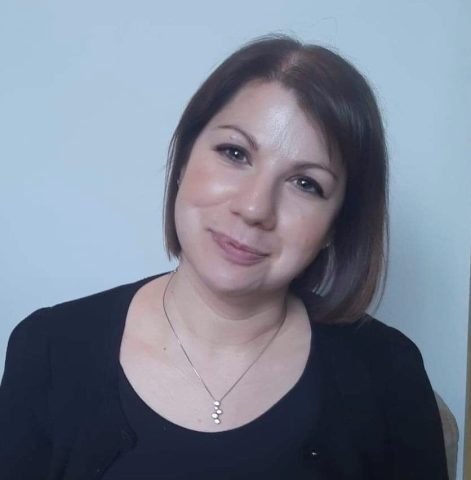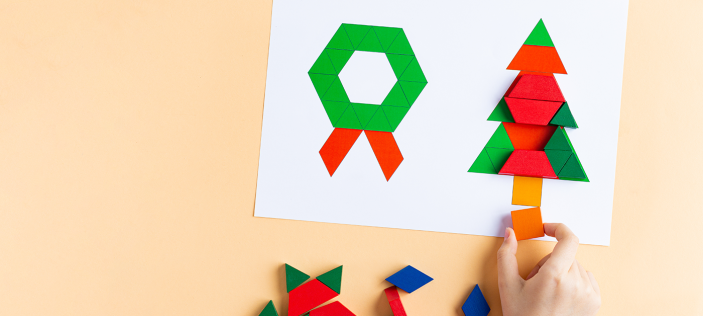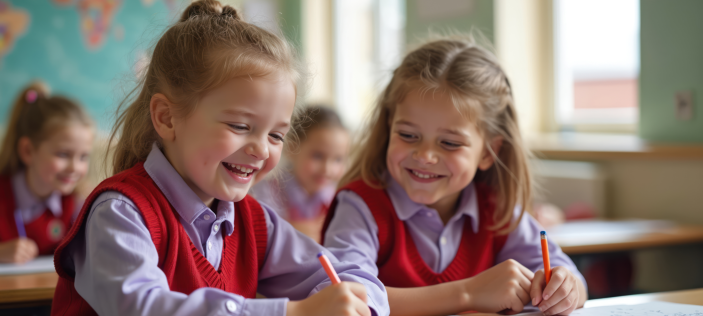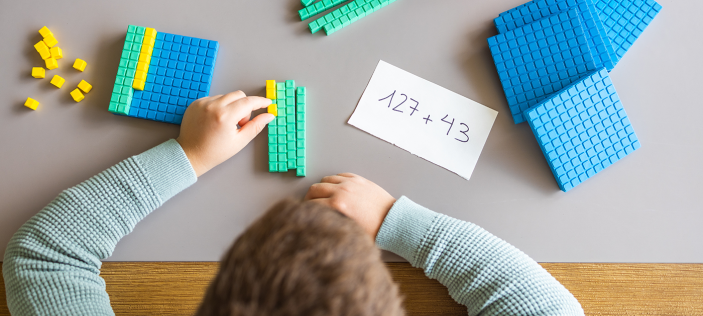This blog has been written for teachers but can be shared by schools with their parents as the ideas within it are useful for the learning of multiplication tables at home.
To get in touch with the HFL Education Primary Maths Team about our blogs, resources and services, email us at primarymaths@hfleducation.org.
Much of the key learning of multiplication tables happens across Year 2, Year 3 and Year 4. It is fair to say that children who know their multiplication tables up to 12 x 12 (with a good amount of understanding as well as recall) cope better with the demands of the maths curriculum in many areas, such as formal written division, equivalent fractions, percentages and ratio and proportion.
So much of the mathematics curriculum in Upper Key Stage 2 is built upon a good understanding of multiplication and division and recall of the multiplication tables. Where a child has not yet remembered the necessary facts or understood their connections to each other enough, they often end up using what becomes an inefficient ‘counting up from 0’ strategy to figure them out. Not having facts at fingertips or fast strategies to get them will slow down the bigger calculations they are trying to solve and place additional pressure on working memory when problem solving (as they are adding in additional steps to work out multiplication facts rather than recalling them).
Many schools ask parents to help at home with the learning of multiplication tables. We think of it, like regular reading, as an area where parents’ support is really beneficial. What we need to do is be more specific about ‘how’ to support this at home. This blog aims to support the ‘how’ to learn a multiplication table (from the beginning) and then also how to rehearse and maintain it.
First, to be clear about the expectations within the National Curriculum from Year 2 onwards, there is specific reference to the recall of multiplication and division facts. It should be acknowledged that some pupils find learning their tables harder than others and so this may not be a smooth path but the general expectations are:
Year 1 – Count in multiples of twos, fives and tens
Year 2 – Recall and use multiplication and division facts for the 2, 5 and 10 multiplication tables
Year 3 – Recall and use multiplication and division facts for the 3, 4 and 8 multiplication tables
Year 4 – Recall multiplication and division facts for multiplication tables up to 12 x 12
Starting from the beginning:
If a child is learning, for example, the 3 x table for the first time, we need to set out a path. This should include:
A lot of what is thought of as practice for multiplication tables, e.g. games using speed of recall, in reality actually falls under the rehearse and recall phases, rather than the initial learning, as they rely on children already having some base knowledge to draw upon. When children begin learning a new multiplication table, it is important to give time for exploration and building a picture of what is happening, allowing the opportunity to physically make the facts and then rehearse them in a range of ways before focusing on the memory and retrieval.
At the ‘learning’ phase, children benefit from seeing the multiplication table build up from the beginning, looking first at one group of the amount (e.g. 1 group / row of 3) and then building up by adding another group / row of 3 each time and seeing what the total becomes. This helps children to link multiplication to repeated addition, e.g. linking 4 x 3 (four rows of three) to 3 + 3 + 3 + 3 and knowing that both make 12.
Any small resource that there are lots of can be used for this. At school, this might be cubes but at home, small toys would work equally well – cars, beads or even a handful of dried pasta. For the purposes of this example, I have borrowed my son’s collection of dinosaurs.
A selection of the arrays (equal rows) are shown. The child would build each in turn, working up through 1x, 2x, 3x, 4x… and talk about each one, noticing how another group / row of 3 is added each time.
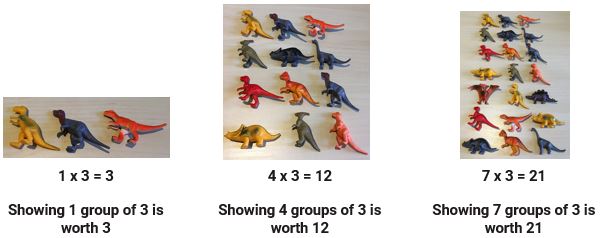
As a note here, it is also good at this stage to talk about no groups / no rows of 3. If there were no groups of 3 dinosaurs, there are 0. This reinforces the idea that 0 x 3 = 0.
Counting and tracking the number of groups on fingers is really important to help children understand one lot more or less as well as to build up a familiar pattern of multiples ready to learn facts. Avoid counting in multiples at the beginning if you want to build a good understanding of relationships between facts. Children generally begin by counting every object in a row at the beginning of skip counting. Help this by encouraging children to ‘whisper’ numbers that are not a times table fact, touching each object and shouting the number of the object at the end of the rows. For example…
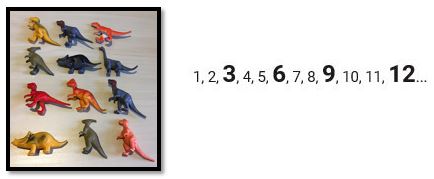
In this array, the child might point to each object starting top right, move along the row whispering 1, 2 and shouting 3, move to the next row whispering 4, 5 and shouting 6 etc. They repeat this on their fingers; tapping a finger and whispering 1, 2 and shouting 3. In school, you could try with cubes on fingers as these teachers, working with the fabulous Professor Jenny Field to develop skip counting, demonstrate below. Over time, encourage children to miss out the ‘whisper numbers’ and skip count more. Finger tracking at this stage is crucial to help children negotiate the number of groups. We can make it more efficient once children can skip count by asking… Do we need to count up from 0? If you can remember your 5th fact, could you count on from there?
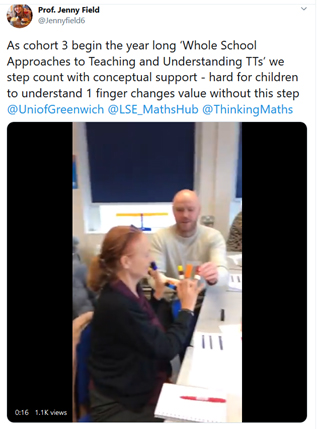
A nice thing to do at this point (with arrays of small items still available) is to turn the facts into a set of cards with the ‘question’ on one side and the ‘answer’ on the back:
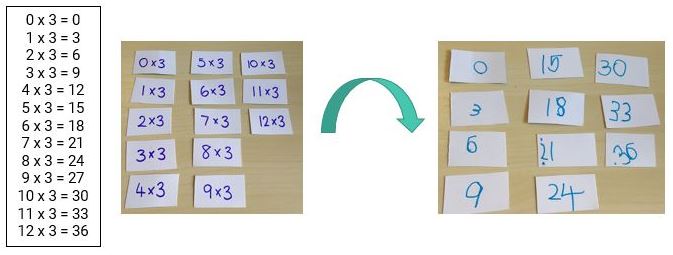
Once these cards have been made, there are lots of options for playing with them; first of all, in order to build some memory recall and then, once the child is starting to remember what is on the back, moving to playing with them out of order to further secure the learning. The point here is about taking time to build confidence and develop memory. Repeated rehearsal should strengthen the memory so don’t rush to reach the out of order and speed rounds.
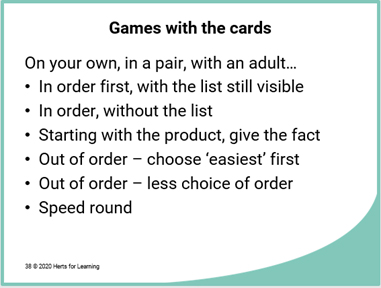
Keep it light and manageable:
- The process needs to be broken up into several steps to maintain motivation and concentration and to build up rehearsal.
- Think about whether to stick to one multiplication table at a time or return to explore a small number of less well remembered facts. It is not a race to learn them all as fast as possible. Focusing on one family or set at a time will allow the child further opportunities to build confidence and develop a more lasting and meaningful memory of the facts.
- Play and create your own games with the cards; whether playing against a partner or children creating their own new rules for using the cards.
- Ask questions such as, “Which facts do you think you already remember?” “Which facts do you think are harder to remember? Why is that?” “How can we remember them?” “How could you use other facts you do remember to help?” This helps children to take more ownership in the learning of facts they see as ‘harder’ to remember (see Further Professional Development Opportunities below for more on this).
- Once you feel a multiplication table has been cracked, keep the cards safe and return to them after a break of a week or two. Revisiting tables to keep them fresh will also help to embed the learning.
Continue the rehearsal:
Once you feel a particular multiplication table is becoming secure, two further elements are needed: application of the knowledge (helping children see when they might need to use them) and also continued rehearsal. This helps to maintain the memory. Application might be about noticing how the knowledge can be used in everyday life or in other areas of their mathematics learning.
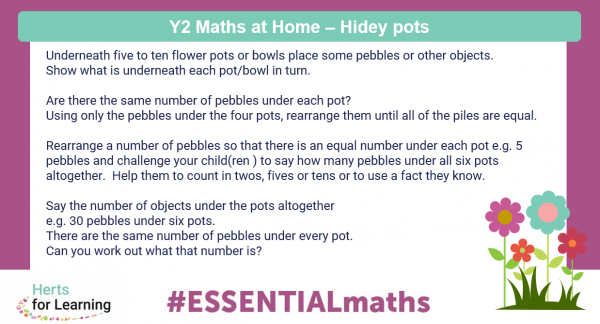
The ‘continued rehearsal’ could be where online games come in and here at Herts for Learning we love a card game. Look out for the games posted @Hertsmaths and our FaceBook group Herts for Learning: ESSENTIALmaths.
The main messages:
Take each multiplication table one at a time. There is a logical order which usually works; 2s, 5s and 10s first (usually around Year 2), 3s, 4s and 8s next (usually around Year 3), then 11s, 6s, 9s, 12s and then 7s come later (usually around Year 4).
Take time to develop an understanding and then memory of each multiplication table rather than skipping to recall; this comes later.
It takes time for most children to develop their memory recall of the full set to 12×12 (and some do struggle more than others to do this) so developing and personalising the approach is important.
Once a table has been rehearsed and is fairly secure, remember to revisit it again and again to keep if fresh.
Further professional development opportunities
Join our digital, on-demand training to explore effective teaching strategies for rehearsal and recall of multiplication facts. The modules are full of practical ideas and resources to take away to enable pupils to learn multiplication facts with understanding and recall.
Supporting pupils to learn multiplication facts – effective strategies for rehearsal and recall
Here is an article that schools could share with parents about the hardest to learn times table facts.
Here is an article that might be of interest to teachers looking for professional development around the teaching of times tables.(pdf)
To keep up to date: Join our Primary Subject Leaders’ mailing list
To subscribe to our blogs: Get our blogs straight to your inbox
